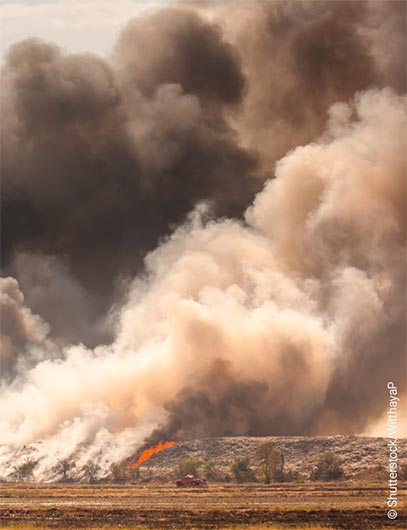
Concentrations of CO2 and other long-lived greenhouse gases (GHGs) continue to increase, driven mainly by people consuming fossil fuels to satisfy ever-increasing demands for energy (well established). 5.2.4 ▸
Given the current concentrations of GHGs and their lifetime in the atmosphere, significant changes in climate and sea levels are unavoidable, with widespread consequences for people and the environment (well established). There is robust evidence that climate change and increased climate variability worsen existing poverty, exacerbate inequalities and trigger new vulnerabilities. However, even greater changes are expected in the future if action is not taken soon to halt GHG emissions. 5.3.4 ▸
Climate change impacts include increased frequency and magnitude of heatwaves and storms (established but incomplete); changes in the distribution of disease vectors, exacerbation of air pollution episodes, and decreases in water supply and impacts on crop yields and food prices. 5.3.4 ▸
Efforts to decrease emissions of short-lived climate pollutants (SLCP), specifically black carbon (BC), methane (CH4), tropospheric ozone (O3) and hydrofluorocarbons (HFCs), are a critical component of an integrated climate change mitigation and air quality management programme (well established). Along with rapid mitigation of long-lived GHG emissions, decreases in SLCP emissions achieve the objectives of the
United Nations Framework Convention on Climate Change (UNFCCC). 5.2.4 ▸
Air pollution is the most important environmental contributor to the global burden of disease, leading to an estimated 6 million to 7 million premature deaths annually and large economic losses (established but incomplete). Of those deaths, 2.6 million to 3.8 million deaths have been attributed to burning wood, coal, crop residue, dung and kerosene for cooking, heating and lighting. Another 3.2 million to 3.5 million deaths have been attributed to other sources of ambient air pollution. The monetary value of the global welfare losses has been estimated at US$5.1 trillion (or 6.6 per cent of global world product). 5.3.1 ▸
People who are elderly, very young, sick and poor are more susceptible to air pollution, which can exacerbate pre-existing illnesses or conditions (well established). Exposures are highest for people living in urban areas in low- and middle-income countries and for the approximately 3 billion people who depend on burning solid fuels or kerosene to meet household energy needs. 5.3.1 ▸
Globally, decreasing emission trends in some sectors and regions have been offset by increasing emission trends in rapidly developing and emerging economies and areas of rapid urbanization (well established). 5.2 ▸
East and South Asia have the highest total number of deaths attributable to air pollution, due to large populations and cities with high levels of pollution (well established). These regions also bear the largest health burden caused by the production of goods consumed in other regions of the world, primarily Western Europe and North America. 5.3.1 ▸
As controls have been placed on power plants, large industrial facilities and vehicles, the relative contributions of other sources have grown in importance (well established). Sources of pollution that are increasingly relevant to achieving air quality objectives include agriculture, domestic fuel burning, construction and other portable equipment, artisanal manufacturing and fires. The relative contributions of these sources to air quality problems differs from region to region, such that priorities for air pollution control may vary in different locations. 5.2.1 ▸
Emissions of ozone-depleting substances (ODSs) have decreased dramatically as a result of the Montreal Protocol (well established). New studies provide robust evidence that stratospheric ozone over Antarctica has started to recover. Although stratospheric ozone concentrations in other regions have increased since 2000, the expected increase in total atmospheric column ozone and decrease in ultraviolet (UV) radiation reaching the Earth’s surface have not been observed outside Antarctica due to natural variability, increases in GHGs, and changes in attenuation of the UV radiation by tropospheric ozone, clouds and aerosols. 5.2.3 ▸
International agreements have been successful in addressing specific chemicals, but new chemical risks are emerging (established but incomplete). Environmental concentrations of persistent organic pollutants (POPs) have been reduced in Europe, North America, Asia and the Pacific, and the Arctic. 5.2.2 ▸
Rapid development and urbanization combined with insufficient environmental governance in many regions suggest that climate change and air pollution are likely to worsen before they improve without additional policy interventions (well established). However, future policy efforts can build upon renewed attention to these issues in international forums and several decades of experience with various governance strategies in different countries. 5.4 ▸